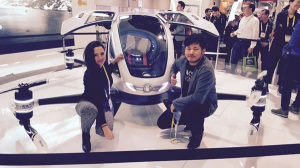Chinese innovators dominate at CES 2016 in Las Vegas
Organized each year by the powerful US Consumer Technology Association (CTA), the Consumer Electronics Show (CES) is the global gathering place for all who thrive on the business of consumer technology. Featuring more than 3,600 exhibitors across 2.4 million net square feet of exhibit space from the Las Vegas Convention Center, from 6 to 9 January CES 2016 displayed the full breadth and depth of innovation in the area of consumer technology.
Not open to the public, the Consumer Technology Association-sponsored show, known to be the world’s largest consumer electronics show, typically hosts previews of products and new product announcements. From small gadgets like smart toothbrushes that can track children’s cleaning moves and report the data to their parents’ tablets, to interactive robots who can answer with the most precise information to all sorts of questions and assist in house chores, CES 2016 was full of surprises.
Out of the 3600 exhibitors of this year, over 1100 came from China, or 30% of the total, a substantial increase relative to previous years. This number is even more impressive if we consider that a large number of non-Chinese suppliers are owned or backed by Chinese investors. This is the case for American hoverboard Segway, recently acquired by Chinese rival Ninebot, mobile health device maker iHealth, backed by Chinese smartphone company Xiaomi, and US automotive startup FaradayFuture, financed by Jia Yueting, Founder of Chinese Internet group LeTV. Chinese companies appear to dominate overwhelmingly certain promising sectors, such as drones and 3D printing.
ChinaEU travelled to Las Vegas to meet some of the most promising Chinese innovators and to identify potential suppliers for the first Internet City, a joint project developed by ChinaEU, CITIC Guoan and China Internet Development Foundation and expected to be completed by 2020.
Drones: DJI, Tencent and EHANG
CES dedicated more than 2300 square meters
Shenzhen-based DJI is famous for being the world’s largest manufacturer of consumer drones. The company announced Phantom 3, its first ever drone to feature a 4K camera for under 1,000 USD.
Leaders from Tencent Entertainment and Shenzhen Xiro unveil new consumer drone YING
Less expected is the move by the leading social media platform Tencent into the drone industry – in partnership with Shenzhen Xiro. The result is the YING, an ultra-light and highly performant drone generation.
However, a third competitor, Guangzhou-based EHANG, stole all media attention. This company stepped into unchartered waters unveiling EHANG 184, the world’s first fully autonomous electric aerial vehicle, designed to fly a passenger of up to 100kg for more than 20 minutes at a low altitude. The passenger can choose the destination on a tablet located inside the cabin while the rest, take off, flying and landing, is being taken care of by the drone itself, with a remote control center taking control should problems occur.
Claudia Vernotti, Director of ChinaEU, with Derrick Xiong, Co-Founder and Chief Marketing Officer of EHANG, in front of the new EHANG 184
The product is already functional, having flown over 100 times in a restricted area in Guangzhou and also with a person on board, and EHANG will start to commercialize it by the end of this year selling at around USD 200,000, Derrick Xiong, Co-Founder and Chief Marketing Officer of EHANG, told to ChinaEU. The company has raised over USD 52 million since it was founded in 2014. Tight controls on drone usage are expected to be introduced in China, while the EU and the US are both discussing new regulations for drones. These will of course have a huge impact on the future commercialization of EHANG 184. But, isn’t this history repeating itself since the introduction of the first powered planes early last century?
Alibaba.com
China’s number one e-commerce marketplace Alibaba.com never stops developing innovative solutions to increase the easiness of online shoppers. This year it presented Alibaba.com Trade Assurance to create trust in trade, allowing buyers on Alibaba.com to enjoy free insurance against product quality failure and delivery delay by the supplier.
AntVR
Now mainly used for enhancing the gaming experience, virtual reality (VR) has many other potential applications, including in architecture design and in education. The unquestioned champion of virtual reality (VR) is probably US-based Oculus, who this year released Oculus-Rift, attracting masses of visitors willing to queue hours to test the new device. But new entrants are adventuring in the industry.
Among these, featuring at CES this year was Chinese startup AntVR, who is challenging the supremacy of Oculus by offering an open-source, cross-platform VR gaming set, called the AntVR kit, bypassing the incompatibility problems existing between VR products and gaming platforms. A universal VR set priced at only USD 300!
LeTV and connected vehicles
Connected cars was another main product category in CES 2016, with a whole exhibition floor dedicated to the automotive industry. Ford has announced its agreement with Google presenting automated electric cars. Chinese tech companies are not absent in this field.
LeTV, famous in China for its smart TV applications, advertised its partnership with British luxury sports car maker Aston Martin to provide in-car “infotainment” systems, meaning all hardware devices to offer audio or video entertainment, automotive navigation systems, Internet, etc. Also in CES, LeTV showcased a fully fledged connected bicycle, which can at the same time provide navigation system and online music, while registering the cycler’s hearth beat and calories consumption.
Innovative smartphones and smart home solutions: ZTE
ZTE, leading supplier of telecom equipment worldwide, presented its Smart Home. The smart home is the most dynamic segment of the Internet of Things. Every device in our home will someday be connected to a network, controllable through the Internet and a platform for services. With its Smart Home, ZTE showed its ambition to be also a leader in this new market.
However, ZTE was, before all, put under the spotlights with the awards that it received from the International Data Group (IDG), one of the world’s leading tech, media, event and research companies: the Global Smart Connected Devices Top 10, Global Smart Phones Top 10, Global Top 50 CE Brands, and Top 10 Brands from China.
These awards acknowledged among others the performance of ZTE’s high-end flagship mobile phone line AXON, including the AXON Pro, AXON MAX, and AXON mini. The most recent models were showcased illustrating the focus of the company on a more convenient user experience. ZTE is for example the first manufacturer marketing a pressure-sensitive touch screen, incorporated in the AXON mini (Premium Edition). Moreover, all AXON models are made from aircraft-grade aluminum-titanium alloy and they feature Hi-Fi audio, an expandable memory and different biometric authentication options – fingerprint, voice control, and eye-scan. At CES, ZTE also presented the AXON Watch, the first running Tencent’s TOS+ operating system.
High definition Internet content: Dr Peng
Dr Peng Telecom and Media Group is China’s 4th mobile operator, better known through its subsidiary company Great Wall Broadband. Dr. Peng is making effort to deploy international OTT platform, as well as a 6-in-1 globally unified telecommunication platform combining broadband, Internet TV, voice, smart home, online education and MVNO. Dr. Peng has already deployed overseas businesses in Korea and the US, promoting 4K level HD ultra broadband applications and Domy series of intelligent terminals, and it is now looking to enter in Europe. With its cloud + service matrix, Dr. Peng aims to create a unique global “Cloud-Broadband-Terminal” ecosystem.
Smart food production
Hydroponics, a method of growing plants using mineral nutrient solutions and water, without soil, is not new in concept, having been practiced since the 16th century. What is new of this technique is its sophistication and its ability to disrupt the traditional food production by becoming a mass consumer solution. OPCOM Farm is challenging the sector by bringing soil-less food production on the cloud. As with any other industry, also in this field competition is becoming fierce.
While OPCOM showcases its new products at the CES, Alesca Life, a new Chinese startup, has won first place at the 2016 CITIC Guoan Young Innovators Competition, which follows last year first award at the 2015 Tech Crunch Beijing Startup Competition. Founded in 2013 with the mission to make sustainable and nutrient fresh food available to anyone, the startup has developed climate controlled facilities and operational management software tools to enable anyone anywhere to grow the safest, healthiest, and freshest produce using their smartphones. Alesca Life will be the first startup to enter China’s future Internet City.
XYZ Printing
Taiwan-based XYZ Printing is the world’s biggest consumer 3D printers supplier by volume. But besides 3D printing pens and 3D printers using plastic filaments as main input, XYZ is now even able to print food! In only 20 minutes, XYZ food printer can 3D print chocolate, sugar, cookie dough, icing, and similar prepared mixtures into edible cookies ready for baking. A USB can be plugged in the machine telling it how the biscuits should look like. This will be a revolution for the food industry, allowing consumers to select the exact ingredients and the exact quantities that fit with their diet.
Conclusion
The 2016 edition from CES will be remembered as the year of the breakthrough of Chinese innovation. However, a trade fair is still far away from daily life. Many innovations shown will likely never trickle down to our environment. A ‘real life’ alternative to traditional trade fairs will be offered by the new Internet City to be built around the CITIC Guoan Grand Epoch City in Langfang, Hebei Province. The project will be officially launched on 22nd January. The city will be equipped with and use 365 days per year only the most futuristic technologies designed from all over the world.













